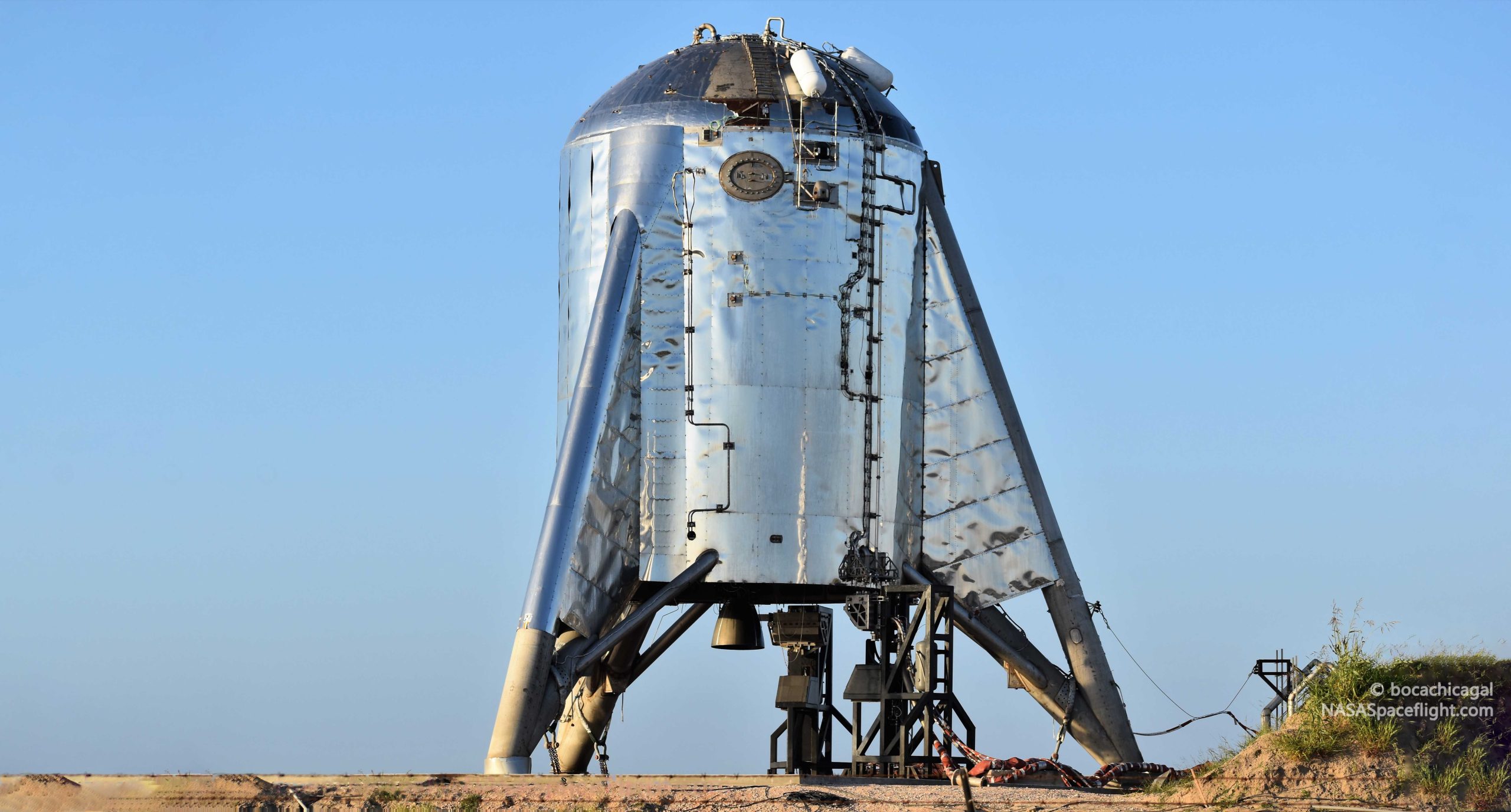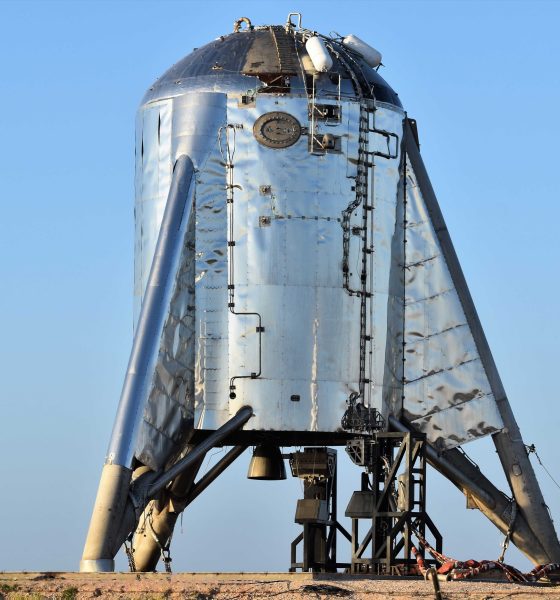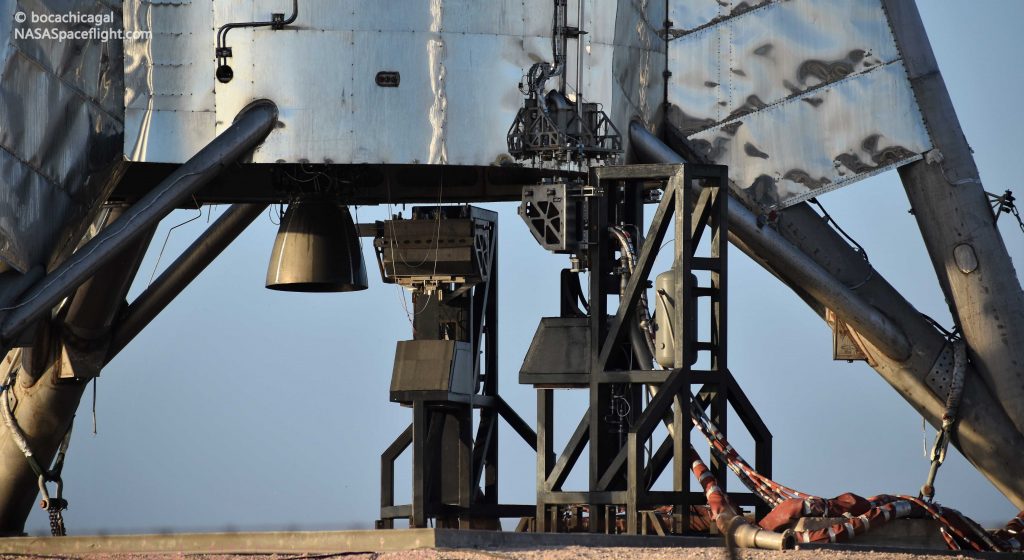

News
Starhopper update: SpaceX’s ungainly Starship testbed survives night of fireballs, Raptor testing
SpaceX’s Starhopper appears to have come out the other end of an eventful night of fires, fireballs, and Raptor testing completely unscathed, although – as with all things rocketry – there is vastly more than meets the eye.
However, signs point towards Starhopper being almost entirely unharmed by its brief voyage inside a fireball – even if Boca Chica’s fire suppression system got a thorough workout and many a SpaceX onlooker likely suffered a partial heart attack. For the time being, it’s safe to assume that Starhopper’s planned flight activities have been indefinitely delayed as SpaceX technicians analyze the vehicle and engineers work to mitigate or completely prevent major fires from recurring.
According to NASASpaceflight.com’s well-informed sources, despite the spectacular fireworks that followed Raptor’s own impressive display, the engine’s static fire test was a full success – at least in terms of data produced by the engine. The large fireball was attributed to the ignition of a large methane vent that followed soon after Raptor’s shutdown.
For now, this means that Starhopper’s untethered flight test and hover test debut should not be expected to occur for several days, even in the event that the rocket, pad, and Raptor engine all made it through their July 16th ordeal completely undamaged. If there is zero damage, this accident will serve as an unfortunate but useful demonstration of a true stainless steel rocket’s theoretically exceptional sturdiness and heat resistance.
Despite suffering what looked like a serious fireball-related anomaly, #Starhopper appears to have been refueled and is visibly venting while the flare stack burns off excess methane. Very good sign that the issue looked worse than it is. Via @labpadrehttps://t.co/sOHShoRByb pic.twitter.com/cs6FSMcZ0T— TESLARATI (@Teslarati) July 17, 2019
It may seem more than a little ironic, but it’s likely less than a coincidence. If it comes to fruition as a truly functional, orbit-capable steel rocket, spaceship, and upper stage, Starship/Super Heavy will exist in their shiny, steel forms almost entirely because of the unintuitive tradeoffs that could theoretically make heat-resistant-but-dense steel more efficient than a ship built out of ultra-light carbon composites. If Starhopper’s newly demonstrated resilience is anything to go by, a very happy side-effect of that efficient, heat-resistant steel could be an almost unprecedented resilience in the face of serious fires, fireballs, and other fire-related anomalies.
For almost any other rocket, exposure – at least outside of the engine section – to large fireballs and quite literally having parts burning while motionless on the ground are deeply, deeply worrisome things and risk a major vehicle malfunction – potentially up to and including a catastrophic failure (i.e. explosion). ULA’s Delta IV rocket family is famous for self-immolating during ignition and liftoff, a minimal concern to the rockets’ thin, aluminum tankage thanks to several inches of thick, fire-retardant foam insulation.
For a rocket like Falcon 9, almost entirely (by surface area) composed of thin, aluminum propellant tanks and carbon composite structures, there is a constant struggle to balance the vehicle’s extreme performance with the low melting point of its primary structures (~720 degrees C). The 301-series stainless steel Starhopper and Starship(s) are built out of has a melting point of ~1400 degrees C, nearly double aluminum-lithium alloys.

In short, while it boggles the mind and is decidedly unintuitive to anyone who watched July 16th’s live coverage of the static fire, it’s actually not a huge surprise that Starhopper has suffered serious fire-related anomalies with essentially zero visible damage. In fact, it’s almost impossible to tell that anything at all happened, let alone discerning some subtle sign(s) of damage incurred by fires. It may sound ironic to say so, but rockets and fire just do not tend to like each other much at all.
Time will tell if Starhopper and Raptor are in as good a condition as they appear to be.
Check out Teslarati’s Marketplace! We offer Tesla accessories, including for the Tesla Cybertruck and Tesla Model 3.

Elon Musk
Elon Musk’s X will start using a Tesla-like software update strategy
The initiative seems designed to accelerate updates to the social media platform, while maintaining maximum transparency.

Elon Musk’s social media platform X will adopt a Tesla-esque approach to software updates for its algorithm.
The initiative seems designed to accelerate updates to the social media platform, while maintaining maximum transparency.
X’s updates to its updates
As per Musk in a post on X, the social media company will be making a new algorithm to determine what organic and advertising posts are recommended to users. These updates would then be repeated every four weeks.
“We will make the new 𝕏 algorithm, including all code used to determine what organic and advertising posts are recommended to users, open source in 7 days. This will be repeated every 4 weeks, with comprehensive developer notes, to help you understand what changed,” Musk wrote in his post.
The initiative somewhat mirrors Tesla’s over-the-air update model, where vehicle software is regularly refined and pushed to users with detailed release notes. This should allow users to better understand the details of X’s every update and foster a healthy feedback loop for the social media platform.
xAI and X
X, formerly Twitter, has been acquired by Elon Musk’s artificial intelligence startup, xAI last year. Since then, xAI has seen a rapid rise in valuation. Following the company’s the company’s upsized $20 billion Series E funding round, estimates now suggest that xAI is worth tens about $230 to $235 billion. That’s several times larger than Tesla when Elon Musk received his controversial 2018 CEO Performance Award.
As per xAI, the Series E funding round attracted a diverse group of investors, including Valor Equity Partners, Stepstone Group, Fidelity Management & Research Company, Qatar Investment Authority, MGX, and Baron Capital Group, among others. Strategic partners NVIDIA and Cisco Investments also continued support for building the world’s largest GPU clusters.
News
Tesla FSD Supervised wins MotorTrend’s Best Driver Assistance Award
The decision marks a notable reversal for the publication from prior years, with judges citing major real-world improvements that pushed Tesla’s latest FSD software ahead of every competing ADAS system.

Tesla’s Full Self-Driving (Supervised) system has been named the best driver-assistance technology on the market, earning top honors at the 2026 MotorTrend Best Tech Awards.
The decision marks a notable reversal for the publication from prior years, with judges citing major real-world improvements that pushed Tesla’s latest FSD software ahead of every competing ADAS system. And it wasn’t even close.
MotorTrend reverses course
MotorTrend awarded Tesla FSD (Supervised) its 2026 Best Tech Driver Assistance title after extensive testing of the latest v14 software. The publication acknowledged that it had previously criticized earlier versions of FSD for erratic behavior and near-miss incidents, ultimately favoring rivals such as GM’s Super Cruise in earlier evaluations.
According to MotorTrend, the newest iteration of FSD resolved many of those shortcomings. Testers said v14 showed far smoother behavior in complex urban scenarios, including unprotected left turns, traffic circles, emergency vehicles, and dense city streets. While the system still requires constant driver supervision, judges concluded that no other advanced driver-assistance system currently matches its breadth of capability.
Unlike rival systems that rely on combinations of cameras, radar, lidar, and mapped highways, Tesla’s FSD operates using a camera-only approach and is capable of driving on city streets, rural roads, and freeways. MotorTrend stated that pure utility, the ability to handle nearly all road types, ultimately separated FSD from competitors like Ford BlueCruise, GM Super Cruise, and BMW’s Highway Assistant.
High cost and high capability
MotorTrend also addressed FSD’s pricing, which remains significantly higher than rival systems. Tesla currently charges $8,000 for a one-time purchase or $99 per month for a subscription, compared with far lower upfront and subscription costs from other automakers. The publication noted that the premium is justified given FSD’s unmatched scope and continuous software evolution.
Safety remained a central focus of the evaluation. While testers reported collision-free operation over thousands of miles, they noted ongoing concerns around FSD’s configurable driving modes, including options that allow aggressive driving and speeds beyond posted limits. MotorTrend emphasized that, like all Level 2 systems, FSD still depends on a fully attentive human driver at all times.
Despite those caveats, the publication concluded that Tesla’s rapid software progress fundamentally reshaped the competitive landscape. For drivers seeking the most capable hands-on driver-assistance system available today, MotorTrend concluded Tesla FSD (Supervised) now stands alone at the top.
News
Elon Musk’s Grokipedia surges to 5.6M articles, almost 79% of English Wikipedia
The explosive growth marks a major milestone for the AI-powered online encyclopedia, which was launched by Elon Musk’s xAI just months ago.

Elon Musk’s Grokipedia has grown to an impressive 5,615,201 articles as of today, closing in on 79% of the English Wikipedia’s current total of 7,119,376 articles.
The explosive growth marks a major milestone for the AI-powered online encyclopedia, which was launched by Elon Musk’s xAI just months ago. Needless to say, it would only be a matter of time before Grokipedia exceeds English Wikipedia in sheer volume.
Grokipedia’s rapid growth
xAI’s vision for Grokipedia emphasizes neutrality, while Grok’s reasoning capabilities allow for fast drafting and fact-checking. When Elon Musk announced the initiative in late September 2025, he noted that Grokipedia would be an improvement to Wikipedia because it would be designed to avoid bias.
At the time, Musk noted that Grokipedia “is a necessary step towards the xAI goal of understanding the Universe.”
Grokipedia was launched in late October, and while xAI was careful to list it only as Version 0.1 at the time, the online encyclopedia immediately earned praise. Wikipedia co-founder Larry Sanger highlighted the project’s innovative approach, noting how it leverages AI to fill knowledge gaps and enable rapid updates. Netizens also observed how Grokipedia tends to present articles in a more objective manner compared to Wikipedia, which is edited by humans.
Elon Musk’s ambitious plans
With 5,615,201 total articles, Grokipedia has now grown to almost 79% of English Wikipedia’s article base. This is incredibly quick, though Grokipedia remains text-only for now. xAI, for its part, has now updated the online encyclopedia’s iteration to v0.2.
Elon Musk has shared bold ideas for Grokipedia, including sending a record of the entire knowledge base to space as part of xAI’s mission to preserve and expand human understanding. At some point, Musk stated that Grokipedia will be renamed to Encyclopedia Galactica, and it will be sent to the cosmos.
“When Grokipedia is good enough (long way to go), we will change the name to Encyclopedia Galactica. It will be an open source distillation of all knowledge, including audio, images and video. Join xAI to help build the sci-fi version of the Library of Alexandria!” Musk wrote, adding in a later post that “Copies will be etched in stone and sent to the Moon, Mars and beyond. This time, it will not be lost.”








